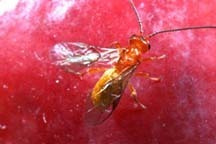• Date: February 04, 2009

This year marks both the bicentennial of Charles Darwin’s birth and the 150th anniversary of the publication of his seminal work "On the Origin of Species." Just in time for the Darwin observances, a new paper appearing today in the journal Science by a team led by University of Notre Dame researchers Andrew Forbes, Thomas Powell, and Jeffrey Feder offers important insights into how new species come to be.
“This study is important because it shows how biodiversity itself can be a major generator of biodiversity,”Feder said.“As new species form, they can create new opportunities for others to take advantage of, which, in turn, can lead to a chain reaction of ever more new species.”
In the paper, Forbes, Powell, Feder and colleagues demonstrate that the parasitic wasp Diachasma alloeum is evolving into a new incipient species as a result of specializing on the Rhagoletis fruit flies that they attack. These Rhagoletis flies are themselves actively diversifying and forming new species.
For the flies, the process begins with a shift to a new host plant. Rhagoletis pomonella flies originally attacked the fruit of hawthorn trees. But about 150 years ago, a portion of the hawthorn fly population shifted and began to feed on apples. In ecologically adapting to apples as a new host plant, apple flies are becoming genetically distinct and reproductively isolated from hawthorn flies. The apple race of Rgagoletis flies is now a major pest of apples in the United States and is the proverbial"worm in the apple."
Every new opportunity opens a world for others, however. The Notre Dame researchers show that the Diachasma wasp that parasitizes Rhagoletis has also shifted to use the fly larvae that feed within the apple as a new food resource. Indeed, the wasp has evolved many of the same types of ecological adaptations to live on flies in apples that the apple fly evolved before it.
And so it goes, with the formation of one new species planting the seed that germinates in the beginning of another.
But in a plot twist, the apple wasp’s ancestors appear to have come from a Rhagoletis fly infesting blueberries rather than hawthornsone turn does not always lead directly to another.
“The idea that there are ‘speciation cascades’ operating in nature has important applications not only for understanding the process of speciation, but also for theories concerning how biodiversity reforms following mass extinction events, for why certain groups of organisms with certain lifestyles may be more diverse than others, and for why certain areas of biotic regions may have more life forms than others,”Feder said.
Where Darwin once traveled to the Galapagos Islands and sleuthed to other far-flung places in pursuit of the origins of species, the research on the apple fly and the apple wasp reveals that important clues to solving his ultimate"mystery of mysteries"can be found all around us, happening right before our eyes in our own back yards.
Other researchers participating in the study are Lukasz L. Stelinski from the University of Florida and James J. Smith from Michigan State University.